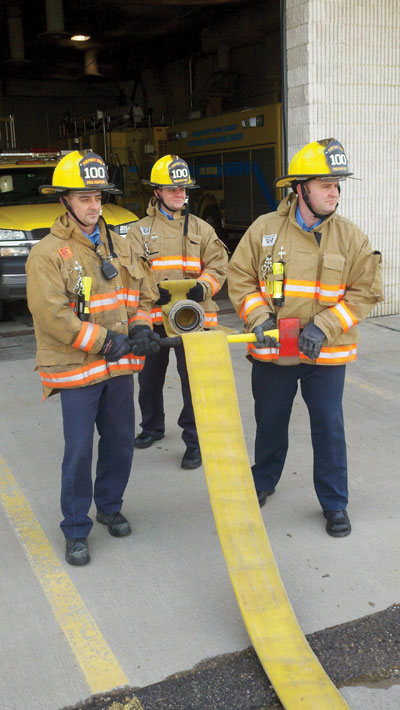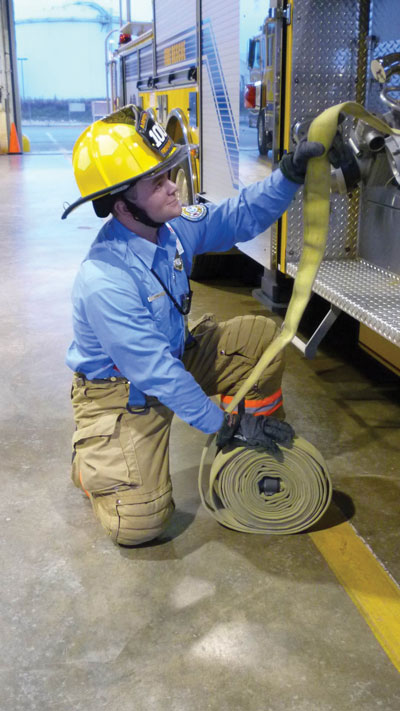
Features
Training
Tim-Bits: January 2012
Many fire departments encounter a problem after the call is over – while firefighters are taking up the hose.
January 6, 2012
By Tim Llewellyn
Many fire departments encounter a problem after the call is over – while firefighters are taking up the hose. All too often, in the volunteer ranks or in departments with low call volumes, the fire hose isn’t used regularly. As a result, it takes a long time to break in the hose, and after it is used, it either remains filled with air or it keeps its filled shape, even though it has been drained and is empty. Then, when the firefighters are repacking, they experience what looks like a poorly packed hose bed, or pre-connected handlines that resemble balloon animals squished into the crosslay trays.

|
|
| To flatten large-diameter hose, three firefighters are needed and all the sections of hose must be uncoupled and laid straight.
|
A solution to the problem for 38-millimetre (1.5-inch) to 77-millimetre (three-inch) hose is simply to roll the hose prior to repacking it. This will force all of the air and water out of the hose and allow it to be re-shaped and flattened before it is repacked (see photo 1). Rolling the hose prior to repacking has a few benefits. No. 1: it requires fewer firefighters to repack the hose – only one firefighter is needed to stand the hose roll on its end on the ground and unroll it as it is repacked (instead of a line of firefighters holding the hose off the ground and walking toward the truck as it is replaced). No. 2: the hose will be carried back to the apparatus rather than dragged. This will save the couplings and hose jacket from premature wear and tear. No. 3: rolled hose takes less space to repack than flat-laid hose. Hose can be repacked in a narrow lane or in the apparatus bay, out of the weather.
 |
|
| Rolling the hose before repacking it forces out the air so the hose will lie flat. Advertisement
|
For large-diameter hose (100 to 125 millimetres, or four to five inches) that won’t lie flat when drained, it isn’t really practical to roll and unroll the hose at the apparatus due to its weight. Lifting and moving rolls of large-diameter hose is strenuous and can cause overexertion injuries. Although ideal, portable hose rollers/reloaders are often expensive and take up considerable compartment space. A simple solution to help prevent air-filled, large-diameter hose is to use the handle of an axe or Halligan to drain the hose. For this operation to work properly, three firefighters are needed and all the sections of the large-diameter hose must be uncoupled and laid straight (see photo 2). One firefighter should lift a coupling end of the large-diameter hose and fold the coupling over, creating an airtight bite in the hose. The other two firefighters should stand side-by-side with the tool’s handle between them at waist height, facing away from the other firefighter. The hose should drape over the handle. The two firefighters should then walk the length of the hose, with the tool handle forcing all the air and water out of the hose as they go – leaving a vacuum-flattened hose behind them.
As they arrive at the opposite end of the hose, and just after the last bits of water and air are forced out, they should create another bite in the hose by folding the coupling end over. A key point to remember is that in order to keep the hose vacuum-flattened, the airtight bites need to remain in place throughout the hose repacking process until the hose is connected to another section or is lying flat in the hose bed.
These two simple tips can be used over and over again to ensure that your apparatus hose beds look neat and orderly, to avoid ballooning, and, most importantly, to deploy the hose correctly and easily when needed.
Tim Llewellyn is a career firefighter for the Allegheny County Airport Authority in Pittsburgh, Penn. A volunteer firefighter since 1989, he currently serves for the Adams Area Fire District in Pennsylvania. He has recently been appointed as a suppression-level instrutor for the Pennsylvania State Fire Academy. He has taught structural firefighting tactics extensively in Canada and the U.S. E-mail him at llewellyn.fire@gmail.com
Print this page